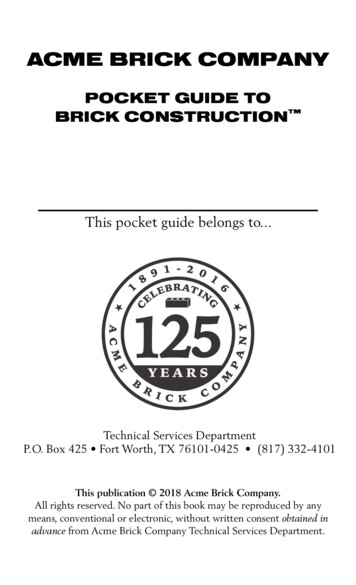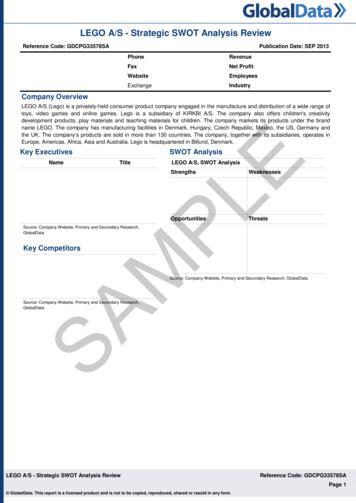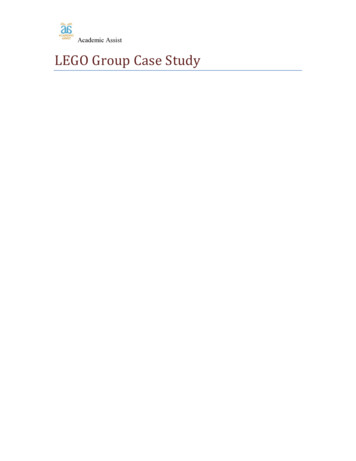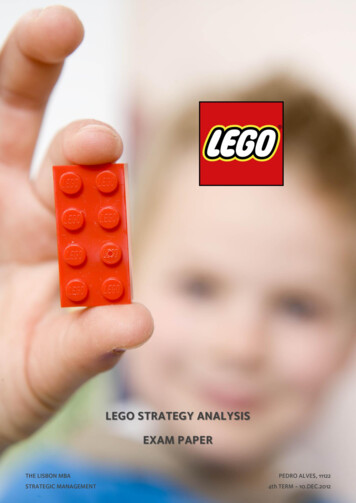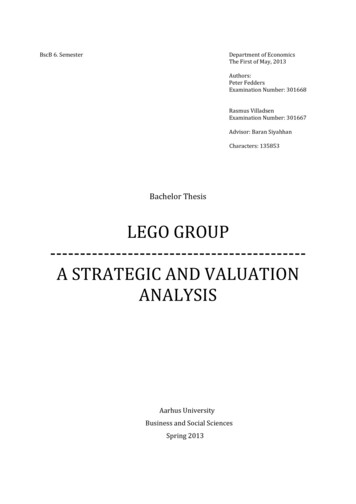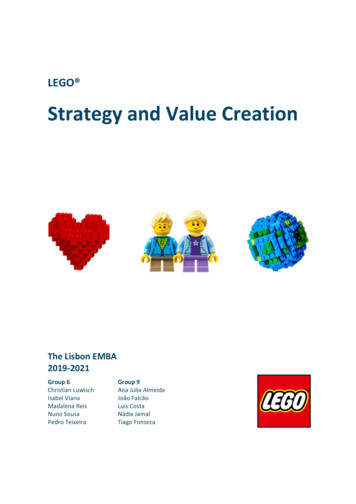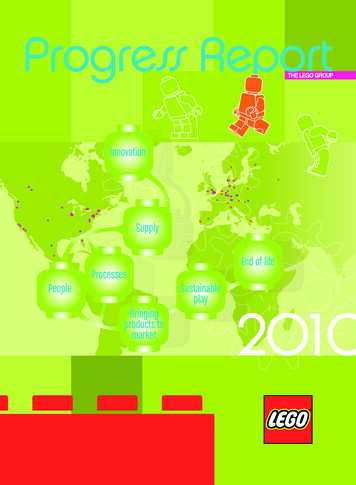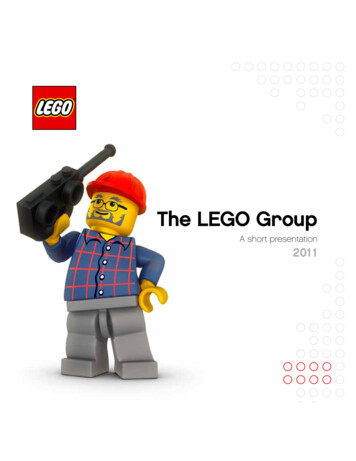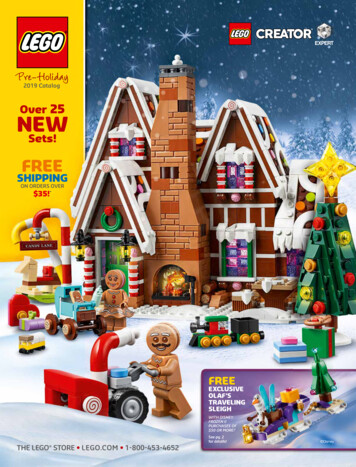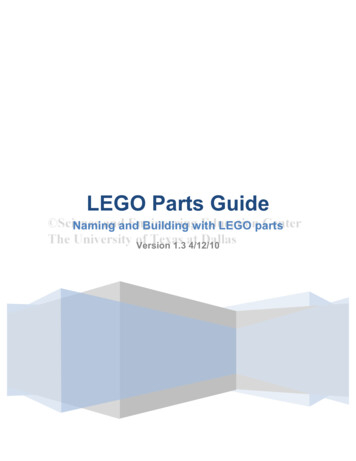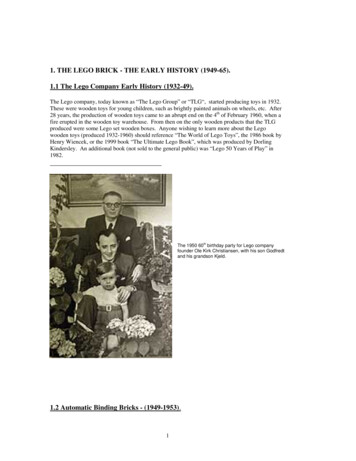
Transcription
1. THE LEGO BRICK - THE EARLY HISTORY (1949-65).1.1 The Lego Company Early History (1932-49).The Lego company, today known as “The Lego Group” or “TLG“, started producing toys in 1932.These were wooden toys for young children, such as brightly painted animals on wheels, etc. After28 years, the production of wooden toys came to an abrupt end on the 4th of February 1960, when afire erupted in the wooden toy warehouse. From then on the only wooden products that the TLGproduced were some Lego set wooden boxes. Anyone wishing to learn more about the Legowooden toys (produced 1932-1960) should reference “The World of Lego Toys”, the 1986 book byHenry Wiencek, or the 1999 book “The Ultimate Lego Book”, which was produced by DorlingKindersley. An additional book (not sold to the general public) was “Lego 50 Years of Play” in1982.thThe 1950 60 birthday party for Lego companyfounder Ole Kirk Christiansen, with his son Godfredtand his grandson Kjeld.1.2 Automatic Binding Bricks - (1949-1953).1
Automatic Binding Brick ElementsThe first plastic bricks produced by the Lego Group (TLG) were sold in 1949 in Denmark only.They were known as “Automatic Binding Bricks”, and looked different from the Lego bricksproduced today. There were no tubes underneath the bricks, no “LEGO” printed on the stud tops(they were flat), and there were slots in the sides of the bricks. . In 1950 a limited number ofAutomatic Binding Brick sets were also sold in southern Sweden, only to be discontinued within ayear, due to poor sales.1949-53 #700/3 Automatic Binding Bricks set box top. No Lego logo on these boxes until 1952.There were only 2 brick sizes produced for the Automatic Binding Brick sets, 2x2 and 2x4. Theywere however produced in about 9 different colors.The Automatic Binding Bricks had 3 window types and 1 door type. These had no studs on top, butdid have “wings” on the sides. These wings were used to fit the windows/doors snuggly into theslots of the slotted bricks. Early examples of the 3 window types also had cellophane “glass”covering the window openings. These were very fragile, and were soon discontinued. Afterwards,all subsequent windows of this type had no “glass”.Because the early bricks had slots on 2 sides of the brick, it was easy to put a picture or postcard intothe slots, and make a picture frame. Automatic Binding Brick sets came with several postcard typecolorful pictures for this very purpose. These colorful pictures were discontinued within a year.The Automatic Binding Brick box tops show an example of bricks used as a picture frame with oneof these colorful postcards.From 1949-50 there were no baseplates for the Automatic Binding Bricks to build upon. The firstbaseplates were introduced in 1951. These were 10x20 stud thin baseplates, available in at least 10different colors. One of the most common was a brownish swirling marble pattern baseplate thatrequired the mixing of several different colors of plastic. These unique thin colorful baseplates werediscontinued in 1953.Lego parts were also sold by Danish Lego retailers as individual parts. This was true for Legobricks, as well as windows/doors. These individual parts were sold from tall/deep colorfully painted2
wooden boxes that the Danish Lego retailers had to purchase from the Lego Company (TLG). Theywould dump the small boxes of loose parts into the large individual parts box, with the parts amixture of parts in different sizes and colors.The Lego Logo used in the 1940’s1949 LEGO ITEMS- Starting in 1949 Automatic Binding Bricks were sold in several basic sets. These were sets (indescending size) #700/1, #700/2, #700/3 and #700/4. Soon after (circa 1950) additional basic sets#700/3A, #700/5 and #700/6 were introduced. For the most part, these same set numbers were usedfor many different versions of basic sets until 1965. These #700/x sets had 2 piece flat boxes, abottom inner box and a box top that fit over it. They were flat and wide. They had cardboard insertsin the bottom half of the box and enough space above to allow a single level of bricks. The smallestbox, the #700/6 had a box in the drawer style. The outer sleeve slid over the inner box bottom. Inthe #700/x sets the bricks were displayed in a zigzag pattern in 4 or 5 different brick colors (red,white, yellow light green and as the sometimes 5th color, medium blue). Starting in 1951, all but thesmallest sets (#700/6) also included the 10x20 thin baseplate, usually in a brown marbled swirlingmulti-color.- From 1949-53 the #700/x box top pictures had a dark green background with “AUTOMATICBINDING BRICKS” printed along the top or bottom edge of the box top. The box top pictured aboy and girl building a multi-color Lego house. All different #700/x sets had the same picture,except the larger sets have Lego models on either or both sides of the central picture.- Denmark is the first country to have Automatic Binding Brick (Lego) sales with the first sets of1949. There are only 6 different Lego elements.- 2x2 and 2x4 slottedbricks were the firstbricks produced for theAutomatic BindingBricks sets of 1949.They were available inall the basic sets of 1949,and only sold inDenmark. These brickshad no “Lego” embossedanywhere on the brick.These first Lego brickswere available in red,white, light green andyellow, with mediumblue coming online ayear later.3
- Windows/doors with“wings” were introduced in1949 with the first bricks.These windows wereavailable in 3 sizes: 1x4x2,1x2x3, and 1x2x2. These1949 windows had “glass”panes made of cellophane.The1x2x4 door typeintroduced that year had nowindow lights, andtherefore no cellophane.These were available inmany colors such as red,white and light green, withother colors such as darkblue and yellow cominglater. These were onlyavailable in basic sets, untilparts packs came online afew years later.1950 LEGO ITEMS- Starting in 1950, the first 2x2 and 2x4 slotted bricks were available with “Lego” in block lettersunderneath. However the old bricks without “Lego” underneath were still being produced. Thesewere only available in basic sets.- Starting in 1950, the 1x4x2, 1x2x3, and 1x2x2 Lego windows with wings no longer had “glass”panes made of cellophane. They were now completely open. The 1x2x4 Lego door did not change.These were only available in basic sets.- #700/3A, #700/5 and #700/6 were new Automatic Binding Brick basic sets first produced circa1950.- First foreign Lego sales. Automatic Binding Bricks were sold in southern Sweden. They were notvery successful, so sales ended within a year or two.Lego logo used in Lego brochures starting in 19514
1951 LEGO ITEMS- Starting in 1951, a new10x20 thin baseplatecame into production.This new baseplate wasavailable in severalcolors, sometimes evenin a marbleized patternof different swirlingcolors. These were onlyavailable in basic sets.1952 LEGO ITEMS1952 saw the first Automatic Binding Brick boxes with the appearance of “LEGO” on the box top.- Starting in 1952, an additional version of the #700/x sets was produced at the same time as theearlier version. The box top picture has a dark blue background with “AUTOMATIC BINDINGBRICKS” printed along the top of the box top, as well as “LEGO Mursten” (“LEGO Bricks” inDanish) printed below it. This is the first year that the word “LEGO” appears on box tops. The boxtop pictured the same boy and girl building a multi-color Lego house as with earlier sets. Alldifferent #700/x sets had the same picture.- Even though the Automatic Binding Brick basic set boxes were primarily found with a blue or agreen background, occasionally other background colors on the #700/x boxes have also been found,such as red.5
Lego logo used in Lego brochures starting in19531.3 Lego Mursten Years - (1953-1955).1953 LEGO ITEMS- In 1953 the #700/x set box top name “Automatic Binding Bricks” disappeared completely, and thenew box designs started to only have “Lego Mursten” (“Lego Bricks” in Scandinavian languages)on the box top. These Lego sets still had the same slotted bricks that the older sets had, but they alsohad a few new items. The #700/x sets that produced from 1953-55, were displayed in their box in acheckerboard pattern in 4 different brick colors (red, white, yellow and light green).- The 1x2 and 2x3 Lego brick started production in 1953. These were only found in red, white,blue, yellow, and light green.The 1953-55 Lego basic set box topshad this very colorful picture of Gunhildand Kjeld, grandchildren of Ole KirkChristiansen, the Lego companyfounder. This box style was usedmainly in larger sets.- A new 10x20 thick baseplate replaced the 10x20 thin baseplate which came into production in1951. The new thick baseplate matches the thickness of the Lego bricks. This 10x20 baseplatereplaced the thin 10x20 baseplate in the #700/1 thru #700/5 basic sets, but not in #700/6 basic sets,which never had a baseplate. It was also available as an individual item from Lego retailers underthe number #700E.6
1953-55 box style used in smaller Lego sets.- In 1953 the first Lego continuous sales outside of Denmark were begun in Norway. However,since imported toys were forbidden in Norway in the 1940’s and 1950’s, TLG licensed a companyin Norway to produced Lego parts/sets there. Note: only #700/x Lego sets were produced for saleNorway. They did not have individual parts (from wooden retailer boxes) that were common inDenmark. Since the Danish and Norwegian languages are similar, the box top words “LEGOMursten” (LEGO Bricks) appeared on all the #700/x sets in both countries. Only the smallblack/white brochure with a few building models, shows the local language.- The #700A small basic set first became available in 1953, and was just an assortment of small 2x2and 2x4 bricks.- The #700B spare parts pack, the first parts pack for Lego,became available in 1953. This pack had an assortment of the1x4x2, 1x2x3 and 1x2x2 windows, as well as the 1x2x4 door.7
This late 1954 Danish Lego catalogshows all the parts that were availablefor sale that year. These were sold asindividual items, in basic sets, or inwindows and doors spare parts packs.1954 LEGO ITEMS- There was a new series of Lego windows and a door that became available in 1954 with “glass”panes. These windows came in sizes 1x6x4 (panorama), 1x6x3 (3 pane), 1x6x3 (shuttered), 1x4x3and 1x3x3, and the door came in size 1x2x4. The large 1x6x4 panorama window had the word“Lego” imprinted (dog bone font) in the plastic window “glass”. These new windows/doors wereavailable in basic sets #700/1, #700/2, #700/3 and #700/3A. These windows/doors were available inspare parts pack #700 C, which had one of each. These windows were available in colors red, white,blue, dark blue and yellow.- New series of large Lego beams. These were available in sizes 2x8,2x10, 2x12 and 2x14 in colors red, white, blue, yellow and light green.The 2x8 and 2x10 were available in the #700/1, #700/2, #700/3,#700/3A, #700/4, #700/5 and #700/6 basic sets, and also available asindividual parts from retailers under the numbers #700/16 and #700/20.The 2x12 and 2x14 were only available as individual parts fromretailers under the numbers #700/24 and #700/28. Ironically the 2x12and 2x14 beams were never available in any Lego set during their short(1954-56) production period. These two larger sized beams have notbeen produced since 1956.8
- There was also a new series of Lego windows and a door that became available in 1954 without“glass” panes. These windows came in sizes 1x6x3, 1x6x2 (3 pane), 1x6x2 (shuttered), 1x4x2,1x3x2 and 1x2x2, and the door came in size 1x2x3. These new windows/doors were available inbasic sets #700/4, #700/5 and #700/6. These windows/doors were not available in a spare parts packuntil 1955. These windows were available in red, blue and dark blue.- New 4x4 (12 stud) cornerbrick. This part becameavailable as individual partsfrom Danish retailers under thenumber #700H.- Also new in 1954 were 1x1 bricks in square and round sizes. These always had the Lego logo onthe “stud”, and never underneath.1949-55 Denmark /1953-55 Norway Sets/Individual Brick - Numbering DK NOR#700/1#700/2#700/3#700/3A#700/4#700/5#700/6#700 A#700 B#700 B/1#700 B/2#700 B/3#700 B/4#700 C#700 C/1#700 C/2#700 C/3Large Basic SetLarge Basic SetMedium Basic SetMedium Basic SetSmall Basic SetSmall Basic SetSmall Basic SetSmall Bricks SetWindows/ Doors Parts Pack (w/o glass)Individual 1x4x2 window (w/o glass)Individual 1x2x3 window (w/o glass)Individual 1x2x2 window (w/o glass)Individual 1x2x4 door (w/o glass)6 Windows/1 Door Parts Pack (w/ glass)Individual 1x6x4 (panorama) window (w/ glass)Individual 1x6x3 (3 pane) window (w/ glass)Individual 1x6x3 (shutter) window (w/ -
#700 C/4Individual 1x4x3 window (w/ glass)1954 -----#700 C/5Individual 1x3x3 window (w/ glass)1954 -----#700 C/6Individual 1x2x4 door (w/ glass)1954 -----#700 EIndividual 10x20 Baseplate1953 1953#700 HIndividual 4x4 corner bricks1954 -----#700 1/4Individual 1x2 bricks1953 -----#700 1/2Individual 2x2 bricks1950 -----#700 3/4Individual 2x3 bricks1953 -----#700 1/1Individual 2x4 bricks1950 -----#700/16Individual 2x8 bricks1954 -----#700/20Individual 2x10 bricks1954 -----#700/24Individual 2x12 bricks1954 1955#700/28Individual 2x14 bricks1954 19551.4 Lego System of Play - The Early Town Plan Years (1955-1958).In 1954 Godtfred Kirk Christiansen, son of the Lego founder Ole Kirk Christiansen made hisfamous ferry voyage to England. En route he had a discussion with a Copenhagen department(Magazin du Nord) executive, and from that discussion he later developed the “Lego System ofPlay” based on the 10 principles that a good toy should have. The Lego company found that theplastic Lego bricks were the best candidate. So in 1955 Lego started the “Lego System of Play”.In 1955
This late 1954 Danish Lego catalog shows all the parts that were available for sale that year. These were sold as individual items, in basic sets, or in windows and doors spare parts packs. 1954 LEGO ITEMS - There was a new series of Lego windows and a door that became available in 1954 with “glass” panes. These windows came in sizes 1x6x4 (panorama), 1x6x3 (3 pane), 1x6x3 (shuttered .
